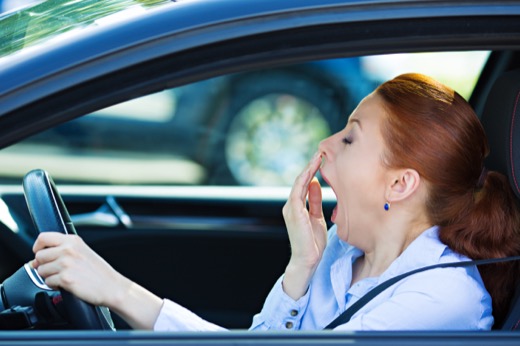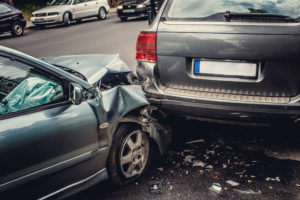In 1988, a Karen Roberts fell asleep while driving after a double shift on Christmas and crashed head-on into another car. The other driver walked away, but Roberts was hospitalized for two months for a traumatic brain injury and still suffers from double vision and headaches 28 years later. Despite having to re-learn even the most rudimentary tasks of life after the crash, Roberts considers herself lucky to have survived at all. She shares her story in the hopes of preventing other drowsy drivers from taking to the road.
We have known for years that drowsy driving is dangerous, but we keep doing it. 60 percent of drivers have driven while drowsy in the past year. More than a quarter of respondents admit to having driven while drowsy several days per month, and 12 percent drive drowsy several days per week. Alarmingly, four percent of respondents drive while fatigued on a daily basis.
Sleep deprivation impairs our driving. When driving drowsy, we are not paying attention to the road, we have reduced reaction times, and we have impaired ability to make good decisions. AAA’s new report, though, investigates the effect of the degree of sleep deprivation on the risk of crashing. Turns out that missing just an hour or two of sleep doubles your risk of a car accident. A driver running on four to four hours of sleep is as likely to crash as a drunk driver. For the drivers who get less than four hours of sleep, they are 11.5 times more likely to crash than someone who has had seven or more hours of rest.
Unlike drinking alcohol—where you can decide if and when you want to imbibe—many drivers find that circumstances largely outside of their control determine when they are on the road. Perhaps you have had an exhausting day at work and end up driving home drowsy. You did not choose to have an exhausting day, and there was little you could do to avoid it. Shift workers, especially, have irregular sleep schedules that disrupt their circadian rhythms and result in fatigue and excessive sleepiness.
Common Characteristics of Accidents Caused by Drowsy Drivers
Most drowsy driving crashes occur after midnight, though many occur in the mid-afternoon. These time periods corresponds to regular human sleepiness patterns. Crashes are also more common on highways and major thoroughfares with high speed limits. This may be attributed to the fact that long distance driving usually involves highways, or that highways are rather boring and are less able to hold a driver’s attention. Drivers suffering from fatigue are also less likely to take corrective action before a crash. This may be due to severely impaired reaction times, or the fact that the driver is asleep. Drowsy driving crashes are also more likely to be serious, potentially due to the combination of occurring on high-speed roadways with a driver that fails to take any corrective action to mitigate or prevent the crash.
Who Is Most at Risk?
- Younger adults (18-29);
- Men;
- Parents with children in the household;
- Shift workers or those with long work hours;
- People on medication that causes drowsiness; and
- People with untreated sleep disorders.
Drivers usually believe that they can tell when they are too drowsy to drive, but overt fatigue is not the only sign that you are too drowsy to be on the road. Instances of inattention are often caused by drowsy driving: having no recollection of driving the last few miles, missing your exit, or drifting from your lane. Do not wait until you have clearly fallen asleep behind the wheel before you decide to pull over.
Tips to Prevent Drowsy Driving
- Get enough sleep;
- Get a ride from someone else;
- Drink some coffee;
- Trade off driving duties with someone else;
- Take regular breaks;
- Stay away from alcohol and medications that can impair you; or
- Take a nap at a rest stop.
If you believe you were injured due to a drowsy driver, an experienced attorney can help you prove your case. Although there is no easy test for drowsiness—unlike using a breathalyzer on drunk drivers—there are ways collect evidence suggesting that the other driver was impaired by fatigue.
The police report filed by the officer investigating the accident may note the driver’s condition at the time of the accident. Sometimes the driver reports fatigue, or having fallen asleep behind the wheel. If the driver does not self-report, the officer may look at other evidence: was the car moving erratically or drifting lanes in a manner that looked like driving under the influence? If so, and the driver does not have a discernable blood alcohol level, then it is quite likely that drowsiness was the reason for driver impairment. In addition to the police report, traffic camera footage or eyewitness accounts may also show that a driver behaving erratically or dangerously.
Since drowsy drivers often fail to take action to prevent the crash, physical evidence—or lack thereof—at the scene of the accident can also suggest driver fatigue. Skid marks, for example, are common when a car brakes suddenly. Therefore, in an accident where the at-fault driver should have stopped but failed to stop, the absence of skid marks would suggest that the driver was too impaired to hit the brakes.
Evidence of factors that may have made a driver more likely to be fatigued can also strengthen your case. Was the driver just working an extra-long shift or a night shift, or driving a long distance? Were they taking any prescription medication that might cause drowsiness? These factors do not necessarily prove that the driver was fatigued, but they make it more likely that the driver was drowsy at the time of the accident.
Get Help Proving a Drowsy Driver Caused Your Injuries
If you or a loved one have been injured in a crash that may have been caused by a drowsy driver, contact the determined Ohio auto accident lawyers at the Ohio Car Accident Lawyers for a free consultation. We can help you assemble the evidence necessary to show that the driver was impaired, and we can fight for full compensation for your injuries.





